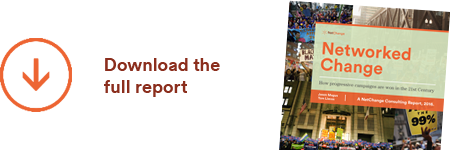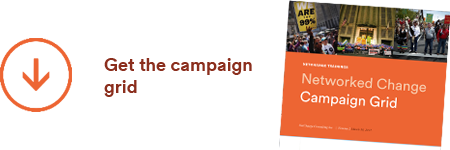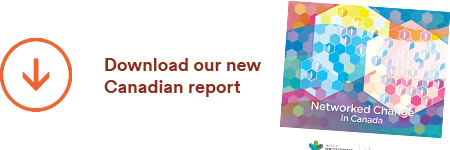 I’ve been thinking of writing a summary of Groundswell: Winning in a World Transformed by Social Technologies for the last couple of months now. I read it in the summer and was very impressed with their process for tapping into the participative web and how it naturally extended the social media framework that we've been building here at Communicopia for over two years now.
I’ve been thinking of writing a summary of Groundswell: Winning in a World Transformed by Social Technologies for the last couple of months now. I read it in the summer and was very impressed with their process for tapping into the participative web and how it naturally extended the social media framework that we've been building here at Communicopia for over two years now.
So, let’s jump right in; Charlene Li and Josh Bernoff (not "Bernhoff" as previously written…sorry Josh) approach social media planning using POST:
- Profile: profile the people who will visit your website
- Objective: Decide which of 5 tactics will meet your organizational objectives
- Strategy: Develop a strategy to meet your objectives
- Technology: Choose a technology and partner to make your plan reality
1. Profile your peeps
The first step is identifying your audience’s level of online participation and grouping them into 6 Social Technographic segments.
- Creators
- Critics
- Collectors
- Joiners
- Spectators, and
- Inactives.
Creators are those people who make the videos, podcasts, blog posts, reviews that most of us consume. In the ecosystem of participants, Creators are the least plentiful and arguably the most important.
Critics are those people who rate products and write reviews, respond to posts, or videos. These are the people who animate the conversation around content and are another high value contributor to social media campaigns.
Collectors are those who collect and categorize content. Reddit.com or Digg.com are good examples of collector behavior in action. They find articles of interest, submit the link to these sites, categorize the content, and leave it for critics and spectators to enjoy and comment on. Other examples of collecting are tagging, subscribing to RSS news feeds, adding to del.icio.us .
Joiners are those participants who have profiles on social networking sites such as MySpace, LinkedIn, and Facebook. Their level of participation is limited to maintaining their profile, uploading pictures, linking to family and friend profiles, and the like.
Spectators are the majority of participants. They may lightly participate on social media sites, like Digg, but mostly consume the videos, the posts and comments, podcasts, forum material, etc. being generated and organized by the other participant types.
Li and Bernoff advocate determining your audience’s participation breakdown so you don’t create, for example, a social network like Facebook but your audience is typically not Joiners. A healthy participant ecosystem will have all segments of the social technographic breakdown but weighted on some profile types more than others. You’ll be more successful if you build a plan around leveraging your demographic’s natural online behavior.
The $100,000 dollar question, literally, is where do you get this breakdown? Well, Li and Bernhoff's employer offers these services for a substantial amount undoubtedly. But what about us who want to do it on the cheap? There are tools like Forresters' Social Technographic Profile Tool , surveys, demographic and competitive analysis sites that can help form a picture of where your audience's behavior my lay. These tools may not be as definitive as a Forrester Research report but it's better than assuming you know what's right for your target audience.
2. Meet your organizational objectives
Once you understand what your audience is currently doing online you're ready to define which of 5 social media tactics will meet your organizational objectives:
- Listening
- Talking
- Energizing
- Supporting, and
- Embracing
Listening focuses on hearing what people are saying about your organization online. Your organization could monitor blogs through Technorati, monitoring tags and descriptions at Del.icio.us, frequenting forums focused on your space, starting your own discussion groups to facilitate conversations between your audience members. Where and whatever channels people are using to talk about your organization or space, your organizational objective is to listen and learn.
I'd also add that listening is an insightful place to begin your social media planning. If your organization isn't new, there are bound to be some blog posts, articles, comments, some chatter about your organization. Before you jump into the social media realm it'll serve you well to listen to any conversations currently taking place. I'll write a post on monitoring the various channels in the future.
Talking is probably the most common social media tactic employed by organizations probably because it’s the easiest to employ. The tactic’s goal is to get broader brand awareness by starting a conversation with and within your audience members. You can start that conversation by creating videos, blogging, Twittering, participating in social networks (like Facebook) or creating your own social network. This strategy is not right for every organization. For example, Walmart created a situation for itself when they created a Facebook group and negative comments came rolling in. You have to consider where to start a conversation and what you’ll do if/when uncomfortable conversations crop up.
The next tactic focuses on energizing people to create buzz or endorsements around your product, service, or organization. Energizing people is done through providing features like review and rating systems, encouraging creators who like your organization (or product or service) to publish about you. The power in this approach is that content generated by an energized constituent is more believable than your marketing department, it’s self-reinforcing as more people extol your product or service, and it’s self-spreading. Think of Apple when you think of this approach–people passionately blog about Apple products, people read about those posts or reviews, they converse amongst their friends about the products using the reviews as supporting material, they buy the product and sing the same praise.
Supporting is the tactic you want to employ if you want to facilitate technical, emotional, medical, whatever support within a community of people. A great example of this is the Tyze website right here in Vancouver. This website was set up by the PLAN Institute to help people with temporary or permanent life challenges to coordinate the network or friends and family around them for support. The Tyze website lets people schedule appointments, plan tasks, connect with others in the network, and connect with each other. It’s a beautiful employment of technology supporting an individual and the people around them.
From a financial perspective, facilitating people to support each other will free up dollars and resources within your organization. On a human level it creates stronger communities, legitimizes people’s expertise, can surface unknown alternate solutions, and allows for a conversation to take place in a public space for everyone to benefit from.
The last tactic of Embracing is employed if your organization wants to foster the collective wisdom, knowledge, and ingenuity of your audience to improve your product or service. A good example is the On/Day/1 campaign by the Better World Campaign. Over the last year this website has sought advice from people on what the next President should do 'on day one' of his presidency. They collected people’s suggestions, let them vote for their favorites, then released the “Top 9 for ‘09."
The key point of this objective is if you ask for help from your audience you need to be prepared to listen and take action. You don’t have to do everything they suggest but you need to be committed to making your audience an acknowleged key member in forming the direction of your organization.
As you can see, your task is to determine which of listening, talking, energizing, supporting, or embracing is the best way to facilitate the conversations that are already happening or needed between your audience members to bring about meeting your organization's business objectives. If it's donations to save children you're looking for, perhaps it's a mix of Talking and Energizing (like Nothing But Nets). If it's mobilizing a group to help each other, Supporting would be right.
In some cases, like PLAN Institute's, the objective is clear. They created Tyze to support their organizational imperative, "…create networks, develop resources, cultivate innovation and promote thinking to foster the contribution of people who are isolated and marginalized." Engaging your audience may not be so clear, however within each method of engaging your audience there are a myriad of creative ways to get a conversation started.
So, once you’ve decided on one or more tactics to meet your organizational goals you'll need to decide your strategy.
3. Outline your strategy
This facet of the POST approach is the least written about approach in Groundswell. What is there can be found throughout the book in the case studies and words of advice from the authors. I'll add some of their thoughts as well as my own.
The biggest piece of advice from the authors is the consideration you must pay to how listening, talking, energizing, supporting, or embracing your audience can reach the outcomes you and your audience hope for. To ensure you don't completely miss the mark the authors suggest you start out small and allow for growth or change as the community of participants gather.
At some point, along with all the positive effects, there will surface negative feedback, comments, or situations that will need to be addressed. A clear plan on how you will respond needs to be in place. Other questions also need to be addressed.
- What resources need to be put in place for support?
- Will the social technologies be incorporated into your organization's website of live offsite?
- Who will lead the charge?
- What performance indicators can be put in place?
- How often do you assess the tactics?
As stated above, you need to choose somebody in your organization that has the authority to lead this bold endeavor and a vested interest in its success. For example, if you’re trying to create a support community, perhaps the VP of Outreach, or similar person should be responsible. Their head is on the block after all, plus can directly monitor the organizational impact of the strategy, and keep the top dog abreast of the status.
4. Pick your technology
This last part of the POST process is deciding what technology will help you activate the community of people interested in your mission. The technology needs to be scalable and flexible as circumstances and strategy change the needs of the organization. The vendor who provides that solution also needs to have the same qualities. They should have a proven track record of application building, community building, and social media awareness to understand the emergent nature and responsiviness needed for a social media strategy.
To sum up
Jeez, what more can I say? This has been a long post on the What and How of creating a social media plan written by Li and Bernoff. Give yourself a pat on the back if you finished this post. Great book if you’re into social media, want to understand the space better, or just want to read some great case studies on social media done well.
If you're interested in Why you might employ a social media strategy, Jason has a few articles that dig into that.
I'm interested in what you think about their approach. Do you see any gaps?









